An email domain is the part of the email address that comes after the @ symbol. For example, in our email address, “support@wpbeginner.com,” the email domain is “wpbeginner.com.”
If you have a business site, then it is really important to get a custom email domain instead of using the generic one that comes with a Yahoo, Gmail, or Hotmail account by default.
Not only will having your own email domain look more professional, but it will also help stop your messages from being sent to junk folders.
At WPBeginner, we use a professional email domain to show credibility and establish a strong brand identity with our readers.
In this guide, we will show you a few different ways to easily get a free email domain for your business.

What Is an Email Domain? (Definition)
An email domain is the web address that comes after the @ symbol in an email address. For example, in an email like syed@companyname.com, “companyname.com” is the email domain.
Email domains allow you to set up a custom email address with a @company name using your own business/brand name.
You can either buy an email domain, or you can get a free email domain for your business when you create a website.
Since there are multiple ways to get a free email domain for your business, we have covered the best options in this guide:
- Method 1: Get a Free Email Domain With Bluehost
- Method 2: Get a Free Email Domain With Hostinger
- Method 3: Get a Free Email Domain With HostGator
- Method 4: Create a Custom Domain Email With Google Workspace (Paid Solution)
- Method 5: Create Domain Email with Microsoft 365 (Paid Solution)
- Which Is Truly the Best Free Email Domain Option?
Ready? Let’s get started.
Method 1: Get a Free Email Domain With Bluehost
Typically, a custom domain name would cost you $14.99 per year, and email hosting services start from $9.88 per month (usually paid annually).
This is a significant amount of money, especially when you are first starting a business website.
Luckily, our friends at Bluehost have agreed to offer WPBeginner users a free email domain with discounted hosting packages.
Basically, you will get a free email domain with a shared hosting plan and a free SSL certificate for $1.99 per month.
Each hosting account includes webmail, email forwarding, spam filter protection, multi-factor authentication, and the ability to use any email client on your mobile phone or desktop to send or receive emails.
Here is how to get your free email domain with Bluehost.
Step 1. Set up your free email domain
First, you need to visit the Bluehost website and click on the ‘Get Started’ button.

Next, you will see the pricing page, where you’ll be asked to select a plan. Basic and Plus plans are popular among businesses looking for an email domain.
Click to select a plan, and you will be taken to the next step. From here, you will choose a free email domain name.
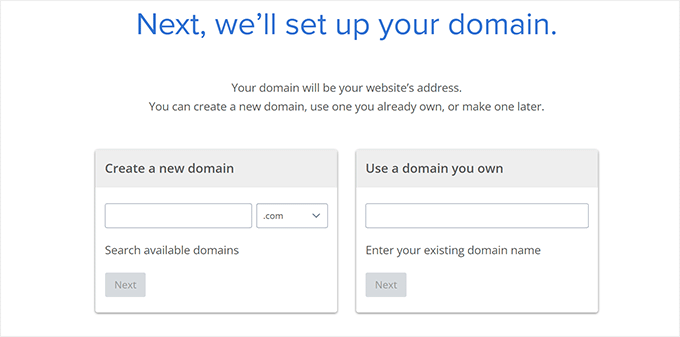
After that, click on the ‘Next’ button to continue.
Bluehost will now check the availability of the domain name you entered. If the domain name is unavailable, then it will show you some alternative options to choose from, or you can just enter a new domain name.
For tips on choosing a domain name, see our article on how to choose a domain name for your business.
After you have selected the domain name, you’ll need to enter your account information and finalize the plan details.
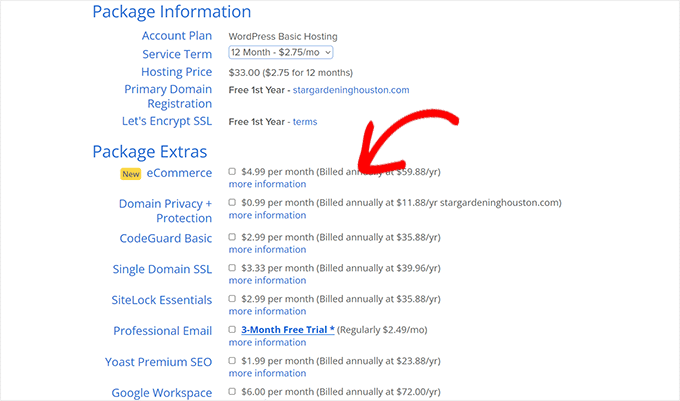
You’ll notice some optional extras on this page. You can safely uncheck them to keep your costs down.
Lastly, you need to enter your payment information to complete the purchase.
You will now receive an email with details on logging in to your account control panel. This is where you manage everything, including email accounts and other settings.
Step 2. Adding email accounts to your domain
Once you log in to your account dashboard, simply switch to the ‘cPanel Email’ tab from the left column.
Here, click the ‘cPanel Email’ link on the right.
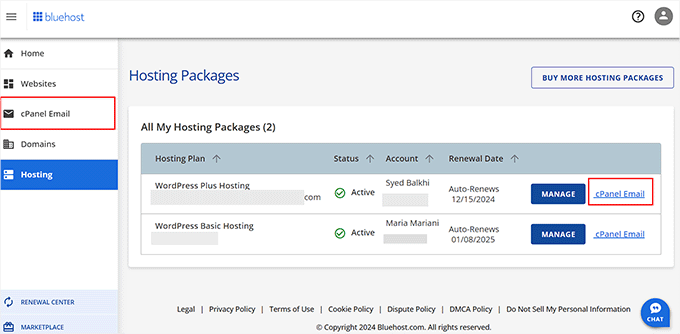
This will open a new prompt on the screen, where you have to choose the ‘Email Accounts’ option.
Once you do that, click the ‘Continue’ button to move forward.
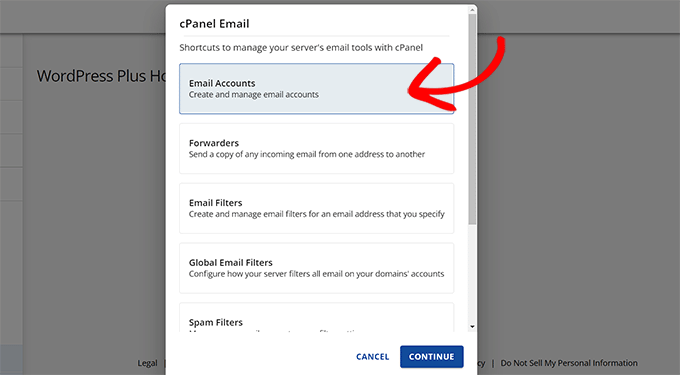
This will bring you to an email account management area.
From here, you need to click on the ‘Create’ button to add a new email account.
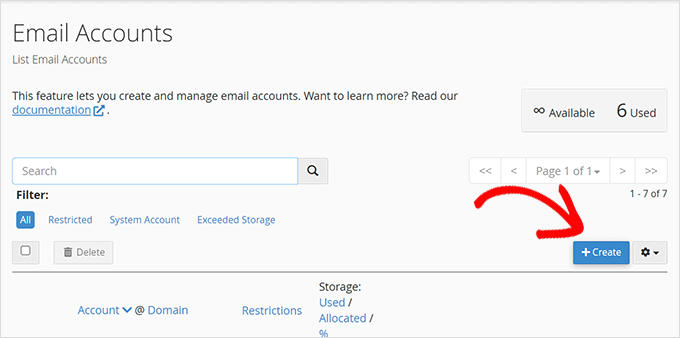
Next, you must enter the email address you want to use and then enter a password.
Optionally, you can choose how much email storage space you want to allow.
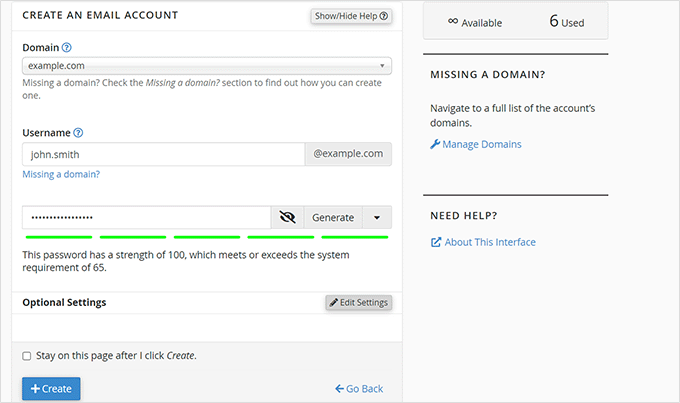
After that, click on the ‘Create’ button to save your new email account.
Bluehost will now create your email account, and you will see a success message.
Step 3. Using your custom domain email with Bluehost
Now that you have created your first account on your email domain. Let’s start using it.
There are multiple ways to use your new email address account.
1. Webmail
Bluehost provides a neat interface to manage your email under your account using your browser.
Simply go to the Bluehost account dashboard and switch to the ‘Advanced’ tab. After that, scroll down and click the ‘Manage’ button in the cPanel section.
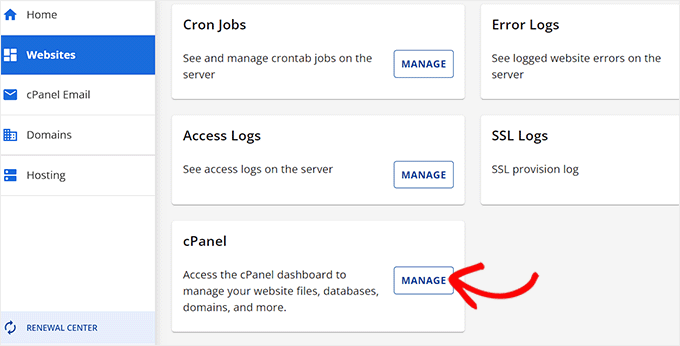
This will open the cPanel (web hosting account control panel) in a new tab.
From here, click on the ‘Email Accounts’ icon under the Email section.
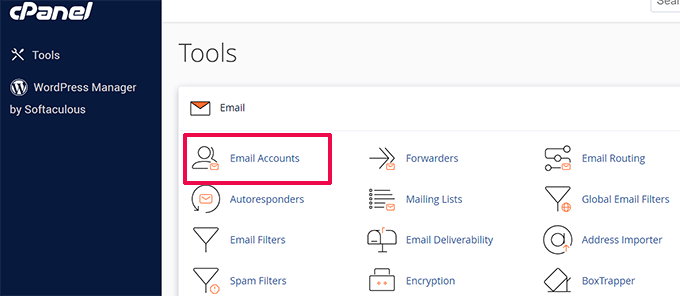
This will bring you to the email accounts page, where you’ll see all your created email accounts.
Go ahead and click on the ‘Check Email’ button next to your email account.
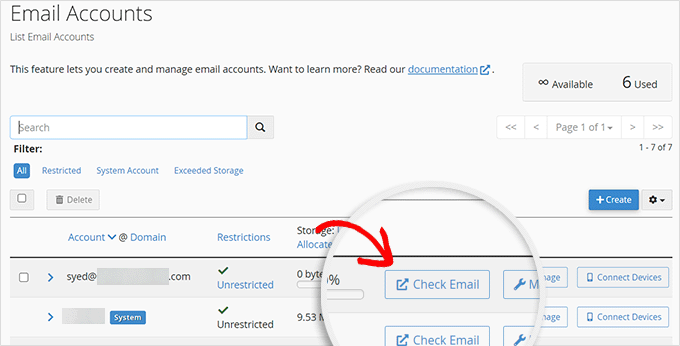
You’ll be asked to select a default webmail app. They all work the same, but Roundcube has a cleaner interface.
2. Other Devices and Apps
You can also send/receive email using any email app on your phone or computer like Outlook, Thunderbird, or another mail app.
Head over to the Advanced page and click the ‘Email Accounts’ icon. From here, you need to click on the ‘Connect Devices’ link next to your email account.
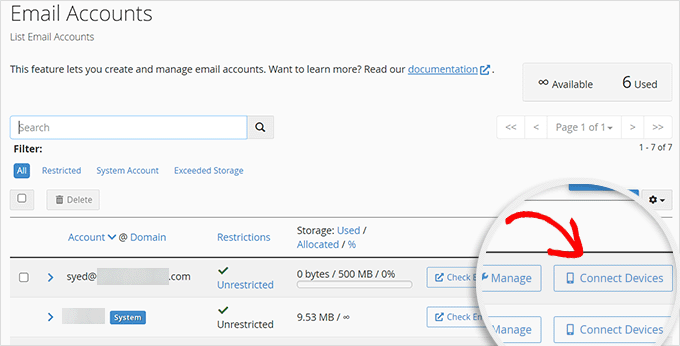
On the next page, you’ll see a list of all popular email apps and devices.
Click on the app you want to connect to, and you’ll see step-by-step instructions to connect with your email client.’
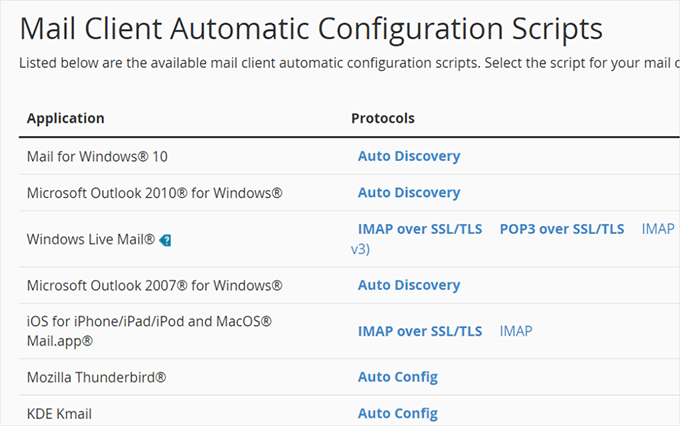
Below the list, you’ll also find manual IMAP settings to connect any other device or app not already listed.
You can also use these outgoing server settings in the WP Mail SMTP plugin to send WordPress emails using an SMTP server.
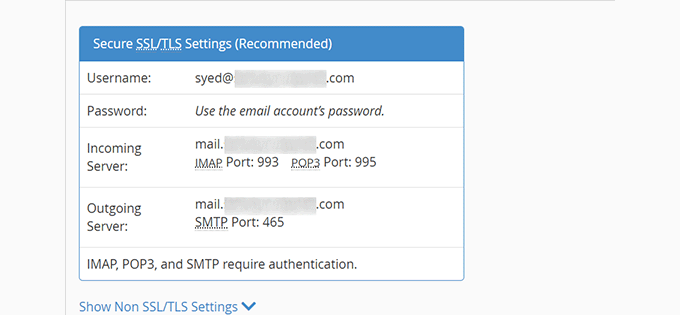
3. Use it with Gmail
Gmail allows you to send and receive emails from your Google account, and you can also use it as a full-fledged email client to get all your emails in one place.
You can send emails using your custom domain email directly from your free Gmail.com account or the mobile app.
Simply log in to your Gmail account, click on the Gear icon at the top, and then click the ‘See all settings’ button.
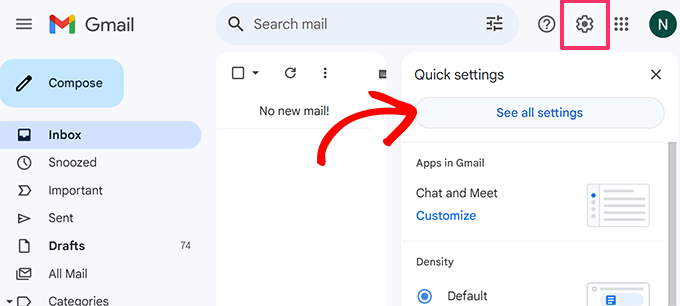
From here, switch to the ‘Accounts and Import’ tab and scroll down to the ‘Check mail from other accounts’ section.
Click on the ‘Add a mail account’ link to continue.
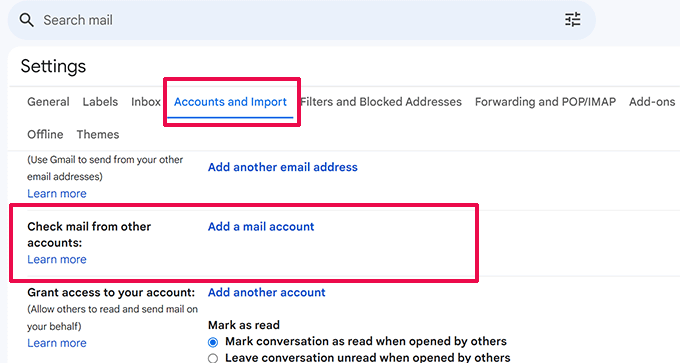
This will bring up a popup where you’ll be asked to add the email account you want to add.
Fill in the custom domain email address you created with Bluehost earlier.
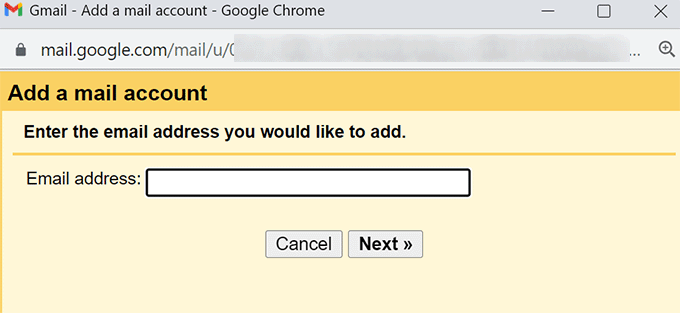
Click on the ‘Next’ button to continue.
The wizard will now ask how you would like to import your emails. POP3 is the only option available for Bluehost mail servers so it will be automatically selected for you.
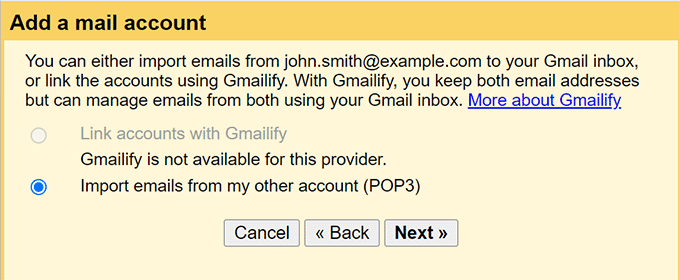
Click on the ‘Next’ button to move on.
After that, you will be asked to provide your account details.
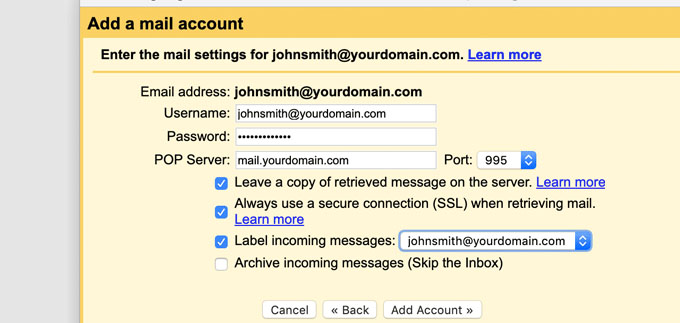
Your username and password will be the complete email address you created earlier and its password. The POP server value will be your domain name with a mail prefix.
You must select the ‘Always use a secure connection (SSL)…’ option and then change the port value to 995.
Click on the ‘Add Account’ button to save your settings.
Next, Gmail will ask you if you would want to use that account to send emails. Select ‘Yes’ and then click on the ‘Next’ button.
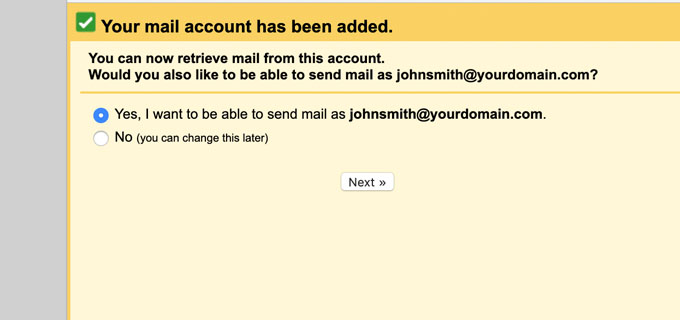
After that, you will be asked to provide a sender name. You can also choose to use this account as an alias.
Basically, an alias is useful when you own two email addresses. For example, an individual’s company email account.
Uncheck the alias box if you want to keep the ownership of this account separate.
For example, if it is your business’s departmental address like support@example.com or info@yourdomain.com.
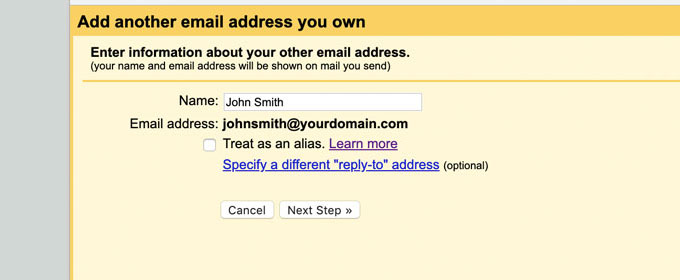
Click on the ‘Next Step’ button to continue.
Now, you will need to provide your server’s SMTP information. SMTP (Simple Mail Transfer Protocol) is the industry standard to securely send emails.
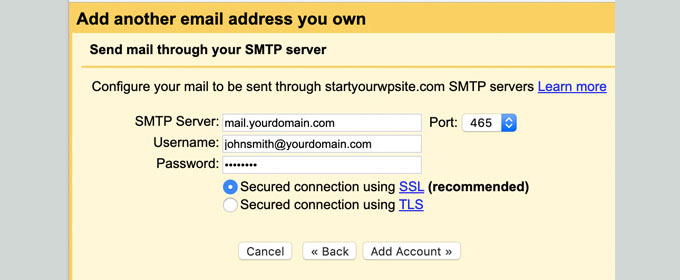
Your SMTP outgoing server will be mail.yourdomain.com (replace yourdomain.com with your actual email domain).
After that, use your complete email address as the username and enter the email account’s password.
Click on the ‘Add account’ button to continue.
Gmail will now send a verification code to the email address. Since you have already added that email address, you will get the email directly in your Gmail inbox.
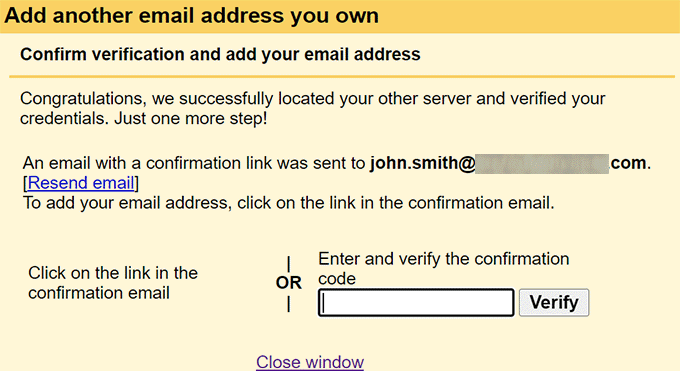
Copy the code and enter it to complete the SMTP setup.
That’s all. You can now use your Gmail account to send and receive emails using your custom domain.
Method 2: Get a Free Email Domain With Hostinger
Hostinger is another popular WordPress hosting company that offers domain, web hosting, and business email accounts.
You can use Hostinger’s free domain to get an email domain for your business. Simply follow the instructions below to set it up.
1. Getting Your Free Email Domain with Hostinger
The folks at Hostinger are offering WPBeginner users an exclusive 78% off with a free domain name and free email accounts.
You can get started for $2.69 per month.
Simply go to the Hostinger website and click on the ‘Claim deal’ button.
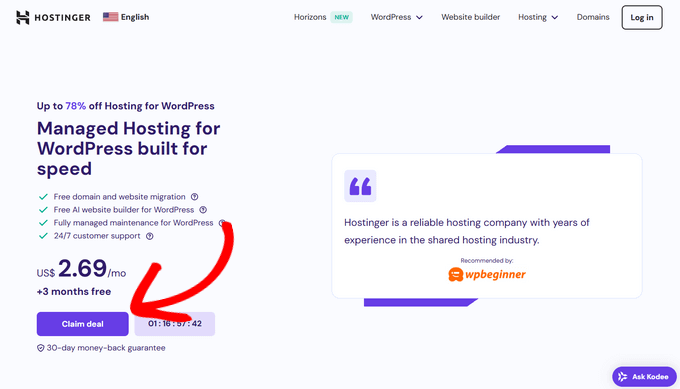
This will take you to the signup page.
First, you need to choose a hosting plan and a hosting period. We recommend picking the Premium plan and the 48-month period, as it gives you the most savings.
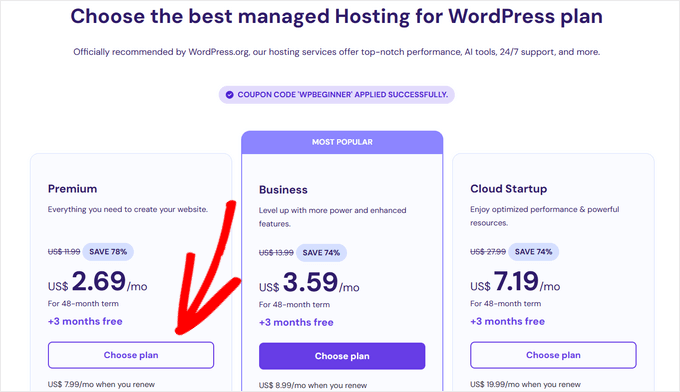
After that, you can create your account and complete the purchase by entering your payment information.
Once you have signed up, you’ll receive an email with instructions to log in to your Hostinger account dashboard.
They call it the hPanel, and this is where you will manage your domain name, website hosting, and email accounts.
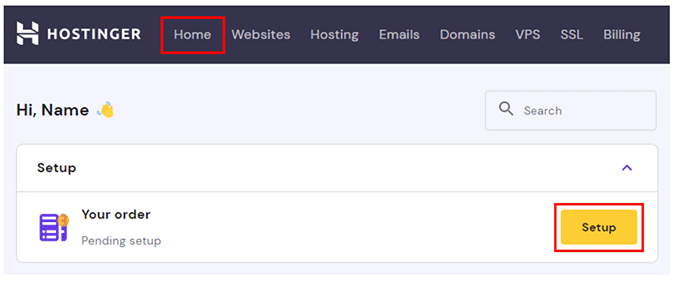
Next, you will be asked to set up your hosting plan. Click on the ‘Setup’ button to continue.
After that, you will be prompted to create a new website or migrate an existing website.
For the sake of this tutorial, you can simply click on the ‘Skip, create an empty website’. Don’t worry. You can always create a website or migrate your existing website later.
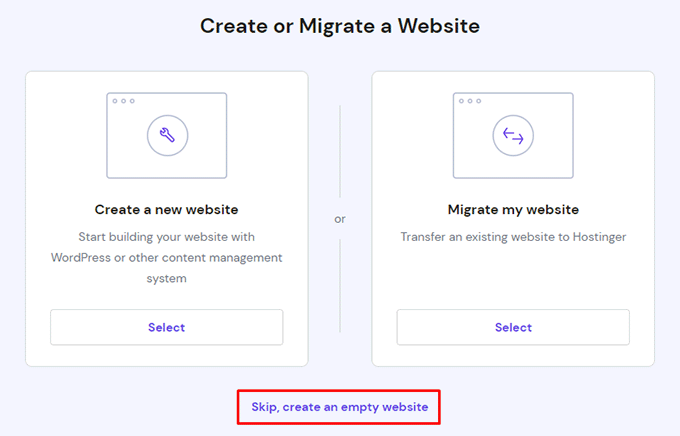
Next, you need to click on the ‘Select’ button under the ‘Claim a Free Domain’ section.
You can see where it is below.
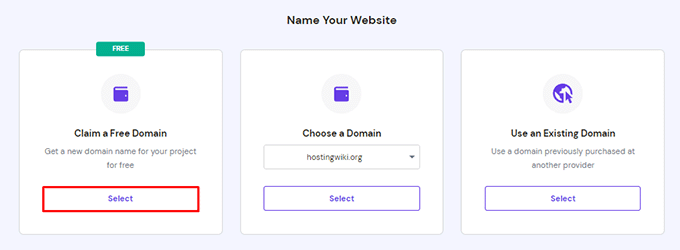
Simply enter the domain name you want to use for your business email domain and click ‘Continue’.
If the domain name is available for registration, Hostinger will register it for you and add it to your account.
Step 2. Setting up an Email Account in Hostinger
Now that your domain name is ready, you can use it to create your professional email address.
Go to your Hostinger account dashboard and navigate to the Emails » Email Accounts page.
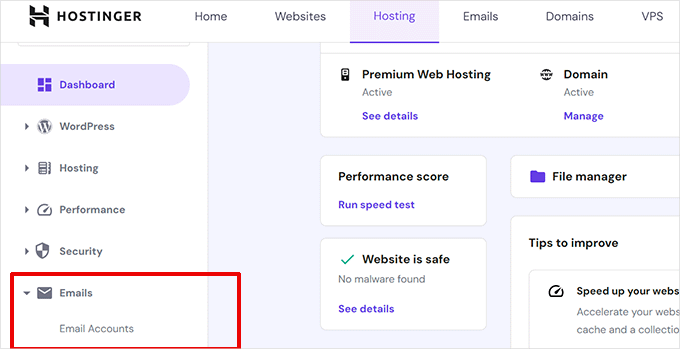
On the next screen, you will be asked to choose the domain.
You need to click ‘Manage’ next to the domain you claimed in the earlier step.
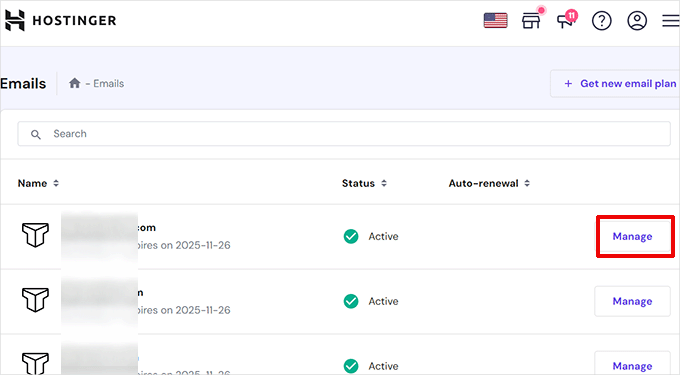
This will take you to the email management area for your domain.
Click on ‘Create a new email account’ to create your first email account.
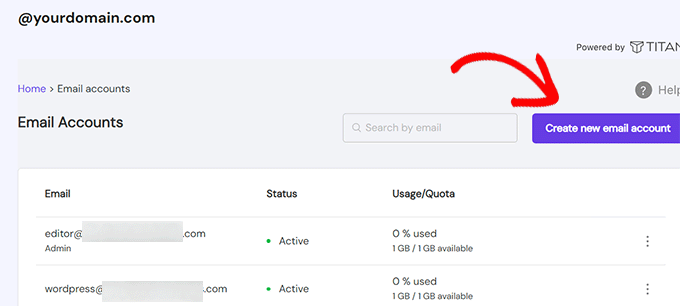
After that, you will be asked to choose a username (the part that comes before the @ in an email address) and a password.
Below that, don’t forget to add a password recovery email address.
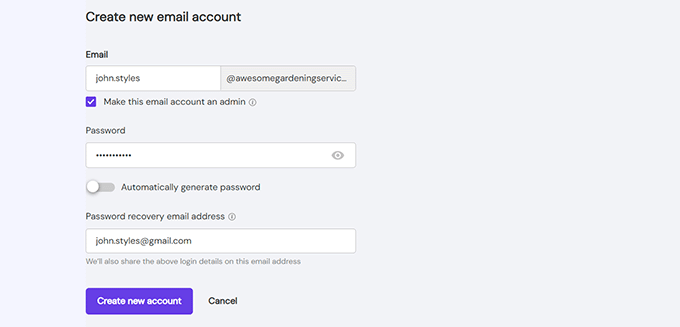
Click on the ‘Create new account’ button, and Hostinger will set up your email account.
Step 3. Using your custom domain email with Hostinger
There are multiple ways to use your newly created custom domain email account.
1. Web Mail
You can access your email account using the webmail feature. Simply go to the email management area and click on the webmail button.
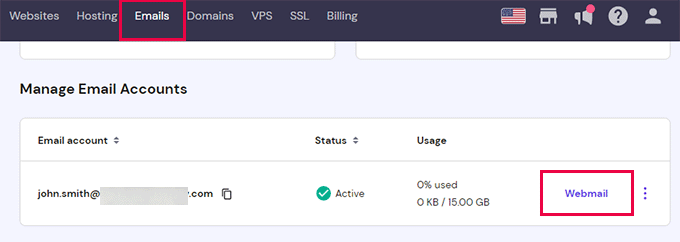
2. Use it with other email apps and devices
You can use any third-party email app on desktop or mobile devices to use your custom domain email address.
This is the information you’ll need to add your email account to third-party email apps.
IMAP (Incoming Server):
Host: imap.hostinger.com
Port: 993
SMTP (Outgoing server):
Host: smtp.hostinger.com
Port:465
Pop (Incoming Server):
Host: pop.hostinger.com
Port: 995
3. Use your custom domain email in Gmail
Lastly, you can also use your custom domain email within your Gmail account.
Simply log in to your Gmail account and click on the settings button. After that switch to the ‘Accounts and forwarding’ tab and click on ‘Add a mail account link’ next to the ‘Check mail from other accounts’ option.
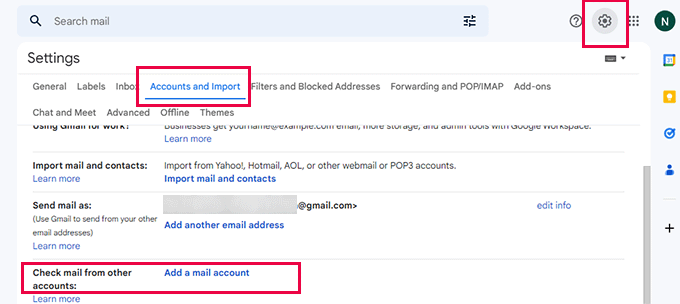
This will bring up a popup, where you need to follow the on-screen instructions to add your account.
Method 3: Get a Free Email Domain With HostGator
Another easy way to get a free email domain is by signing up for HostGator’s hosting plan. They are one of the top web hosting providers in the world and offer excellent plans for startups and small businesses.
We use HostGator to host several of our smaller websites.
HostGator is offering WPBeginner users an exclusive discount on WordPress hosting + a free domain name. Basically, you’ll be able to get started for just $2.64 per month.
You get free unlimited custom domain email addresses with your account. It also includes webmail, email forwarding, and support to send/receive emails using any email client of your choice.
Step 1. Sign up for a HostGator account
First, you need to visit the HostGator website and click on the ‘Get Started Now’ button.

Next, you will be asked to select a plan. Hatchling and Baby plans are the most popular among beginners and small businesses.
Click to select a plan and continue.

After that, you will be asked to select a domain name.
Simply enter the domain you want to register to see if it is available.
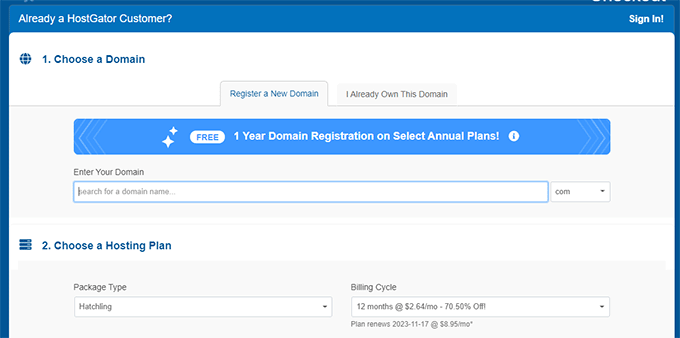
If the domain name is available, then you can click to select it.
Scroll down a little to enter your personal and billing information. After that, you’ll reach the additional services section. We don’t recommend choosing them at this point, and you can add them later if you really need them.
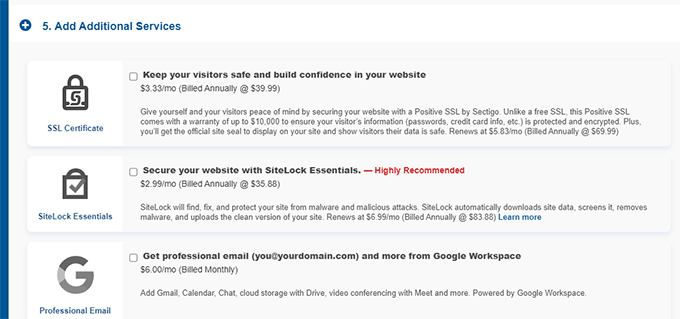
You can now review your order details and click on the ‘Checkout Now’ button to complete the purchase.
You will now receive an email from HostGator with details on how to log in to your hosting dashboard.
Step 2. Create an email account
Login to your HostGator hosting dashboard and click on the Hosting panel on the left column.
On the next screen, select your domain name and then click on the ‘Email Accounts’ button.
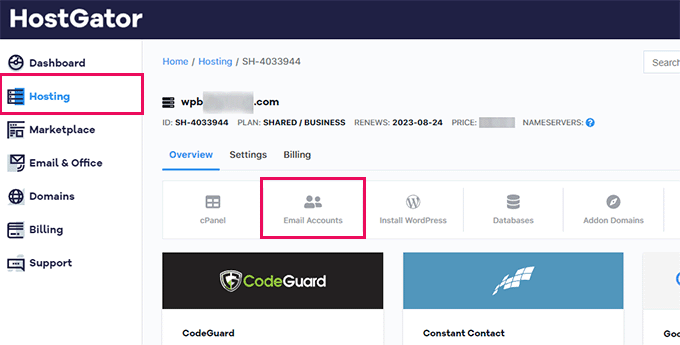
This will launch the control panel where you can manage your email accounts.
Click on the ‘Create’ button to continue.
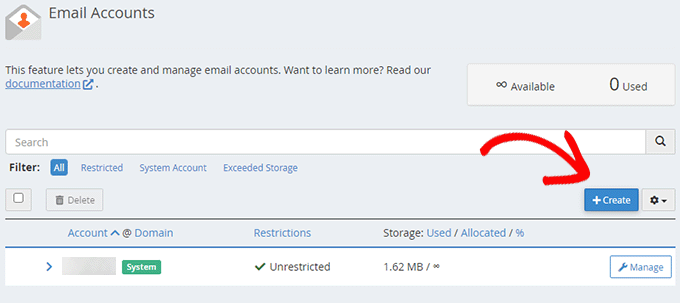
On the next screen, you will be able to create a new email account by entering an email username and password.
Click on the ‘Create Account’ button to save your new professional email address.
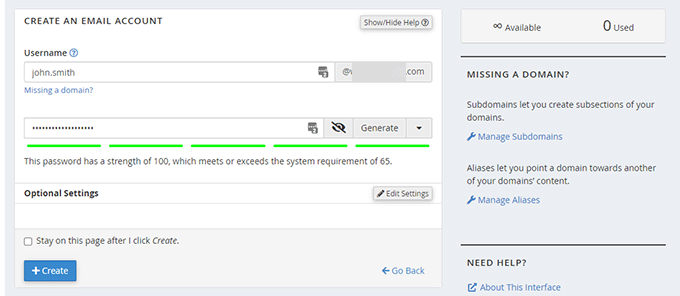
Step 3. Using your custom domain email account on HostGator
HostGator provides the same methods of sending and receiving emails as Bluehost above.
1. Webmail
You can view and send emails directly from your HostGator dashboard. Simply visit the email accounts page and click on the ‘Check Email’ button.
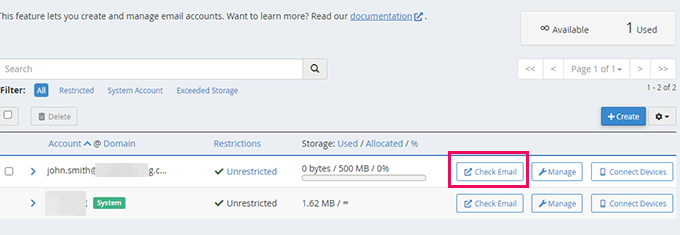
2. Send or receive email using other mail clients and apps
You can also access your custom domain email account using third-party mail apps on your computer and phone.
Here is the information you will need to set up email on different devices and email clients.
Pop3:
Username: Your full email address
Password: The password for the address you wish to access.
Mailserver/ Server Hostname: mail.yourdomain.com
Port: 995
SSL: SSL/TLS
SMTP:
Username: Your full email address.
Password: The password for the address you wish to access.
Mailserver/ Server Hostname: mail.yourdomain.com
Port: 465
SSL: SSL/TLS
You will also use the same settings to send or receive emails using Gmail.
Simply log in to your Gmail account and click on the settings button. After that switch to the ‘Accounts and forwarding’ tab and click on ‘Add a mail account link’ next to the ‘Check mail from other accounts’ option.

This will bring up a popup where you need to follow the on-screen instructions to add your account.
Method 4: Create a Custom Domain Email With Google Workspace (Paid Solution)
Email is crucial for the success of any business, which is why we recommend using Google Workspace (formerly G Suite).
Google Workspace is Google’s suite of applications for small businesses. It allows you to use the same Google apps like Gmail, Drive, Docs, Sheets, and Calendar, but with your own domain name.
You also get Google’s powerful spam filtering and security features for your business email. It is much easier to use and works on all your devices.
Last but not least, Google Workspace is an extremely reliable email provider with very little downtime. This is why we use Google Workspace for our business.
To get started, you need to visit the Google Workspace website and select a plan.
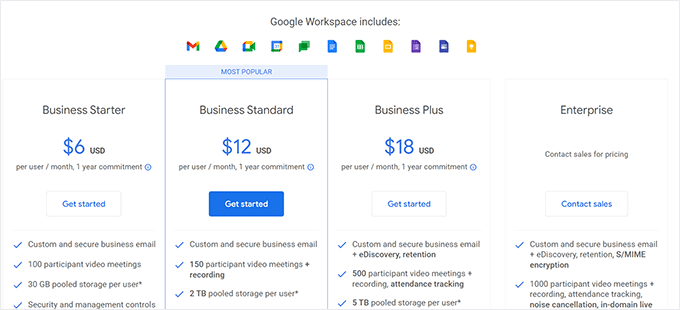
Their basic plan starts from $6 per user per month with 30 GB of storage.
Next, you will be asked to enter your company name, size, and country.
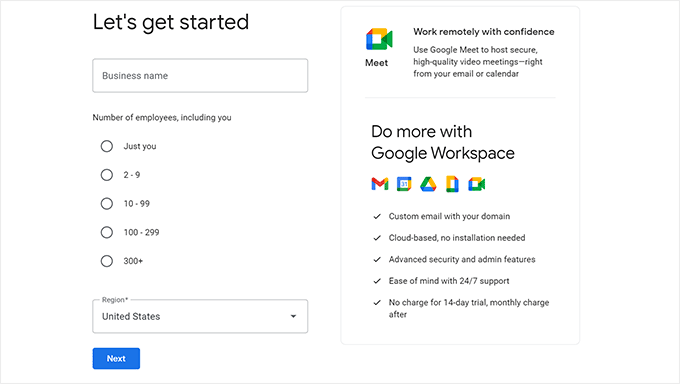
After that, you need to enter your contact information and click on the ‘Next’ button.
This will bring you to the domain selection screen.
If you already have a domain name you would like to use, then you can use that. Otherwise, select the ‘No, I need one’ option.
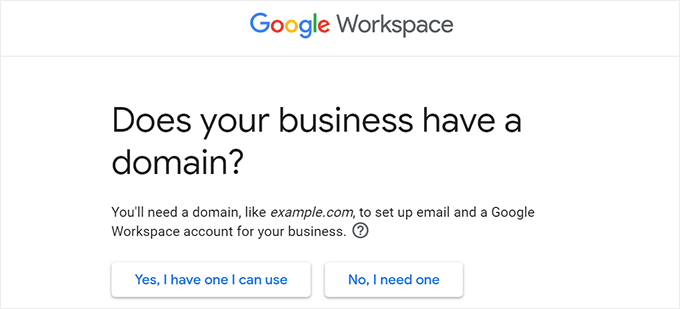
You can now enter the domain name you want to register and click on the ‘Next’ button.
If your entered domain is available, you will see its pricing.
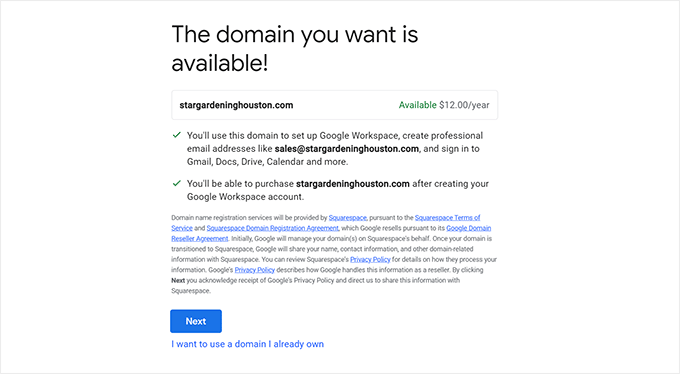
Click on the ‘Next’ button to continue.
After that, you will enter your business information and payment details to finish the process.
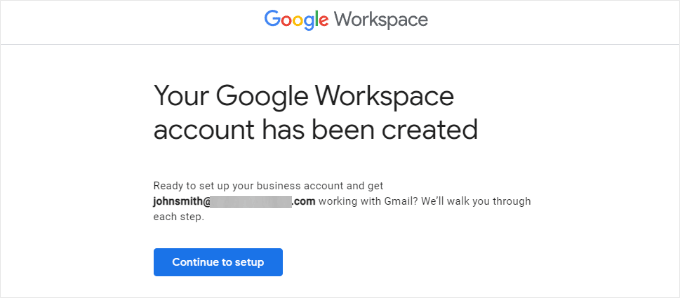
You can now click on the ‘Continue to Set up’ button to start adding email accounts and users from your Google Workspace admin console.
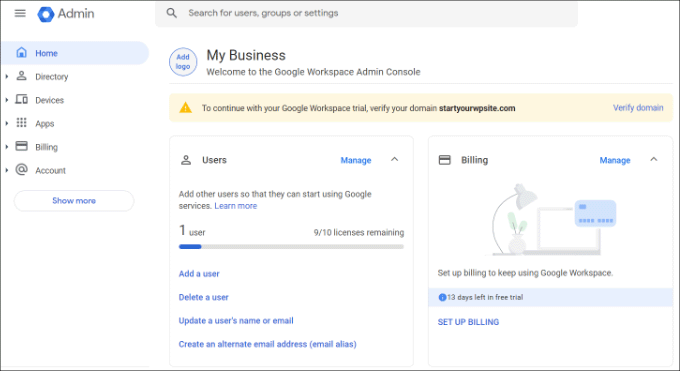
On the setup screen, you can create your first email account.
After that, you can add more accounts for your employees or departments or click on ‘I have added all user email addresses’ and click on the ‘Next’ button.
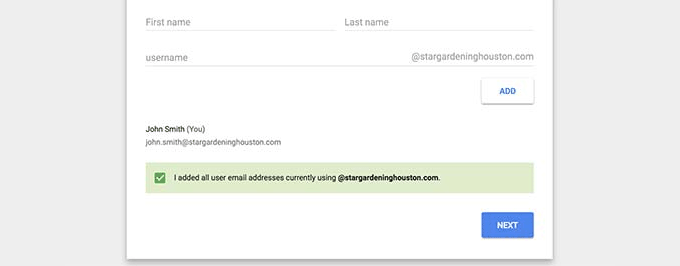
That’s all. You can now use your newly created email account in Gmail and use it with your own custom domain.
You can now use it to sign in to Gmail on your computer and mobile devices.
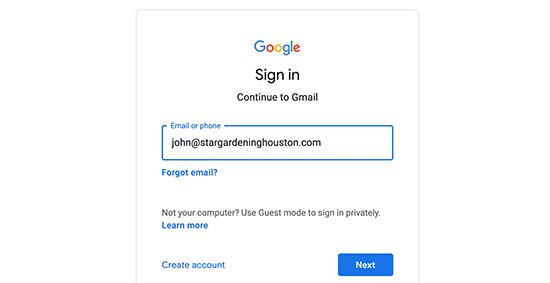
If you need more detailed instructions, then please see our guide on setting up professional email with Gmail and Google Workspace.
Most business owners do not buy an email domain from Google Workspace. Instead, they start with the free email domain services offered by their web hosting companies and then later switch to Google Workspace when they can afford it.
We use Google Workspace for our business because it allows us to better data retention, easy file management, calendar, and many other useful apps to grow our business.
They used to have a free plan, but they no longer offer that. Their premium email service is well worth the cost, especially if you’re an eCommerce business.
Method 5: Create Domain Email With Microsoft 365 Formerly Office 365 (Paid Solution)
Microsoft also provides its office productivity suite called Microsoft 365 with support for custom domain email. In terms of features and functionality, it is similar to Google Workspace
Want to compare both platforms, then see our comparison of Google Workspace vs Microsoft 365 to find out how they stack up against each other.
Here is how to set up your custom domain email with Microsoft 365.
Step 1. Setting up Microsoft 365 with custom domain email
First, you need to visit the Microsoft 365 website and click on the ‘Buy Now’ button under the plan you want to purchase.
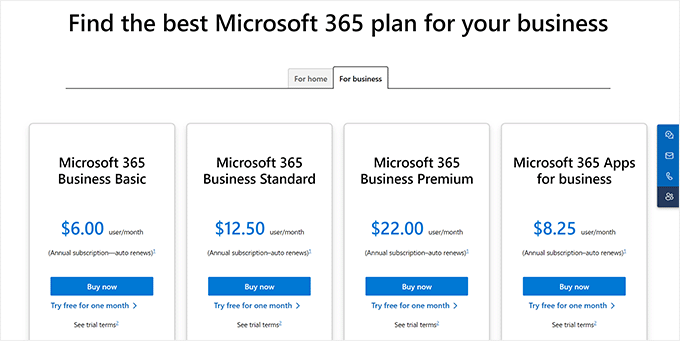
This will bring you the Microsoft 365 sign-up page, where you will be first asked to set up your plan.
You can start with the Business Basic plan, which includes professional custom domain email support. However, it doesn’t come with desktop apps for Microsoft Office products.
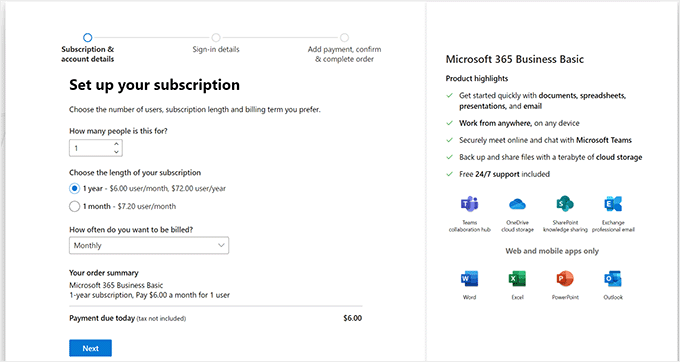
Follow the on-screen instructions by providing a payment method and email address to complete the setup.
Once set up, you will reach the Microsoft 365 dashboard.
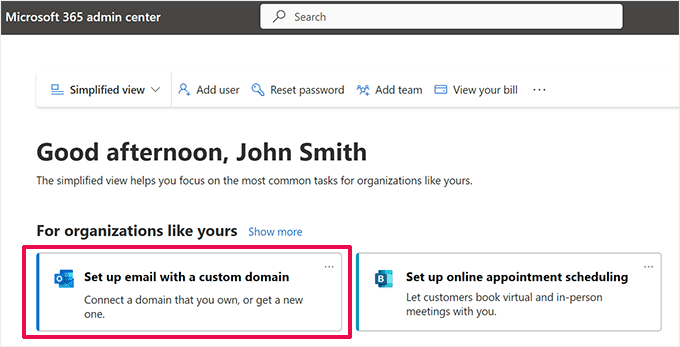
Step 2. Add Custom Domain to Microsoft 365
Microsoft does not provide a domain registration service, so you’ll need to separately buy a domain name or use an existing domain name to add to Microsoft 365.
There are a number of domain registrars that sell domain names. We recommend using Domain.com as they are the best domain registrar on the market.
Simply visit the Domain.com website and look for the domain name you want to purchase. WPBeginner users can use our Domain.com coupon code to get an additional discount.
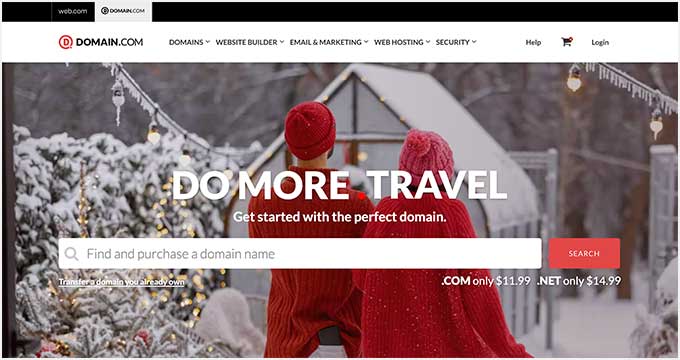
If your selected domain name is available, then you can proceed to the billing and complete the purchase.
Now, you can add this domain to Microsoft 365.
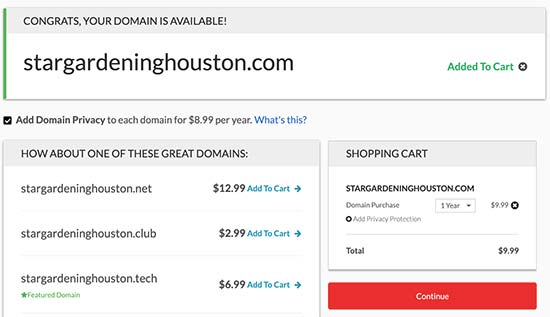
Head over to your Microsoft 365 admin dashboard.
Then just click on Set up email with a custom domain prompt.

This will bring up the custom domain setup wizard.
Since you already purchased the domain name, click on the ‘Use a domain name you already own’ option to continue.
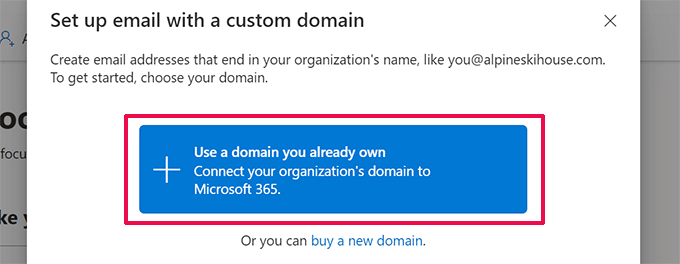
Next, you need to enter the domain name.
Simply enter the domain you purchased earlier and click ‘Continue’.
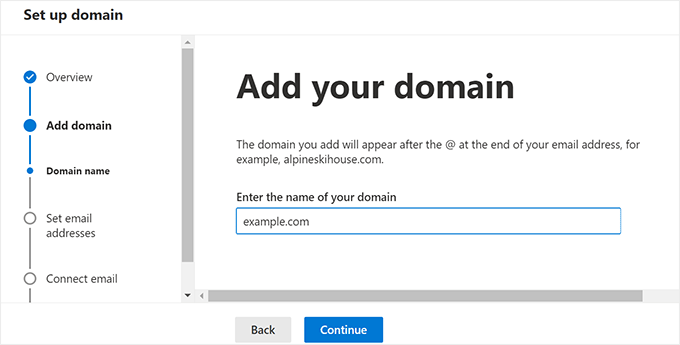
After that, you will be asked to verify your ownership of that domain name.
You will see the TXT record and MX record that you need to add to your domain.
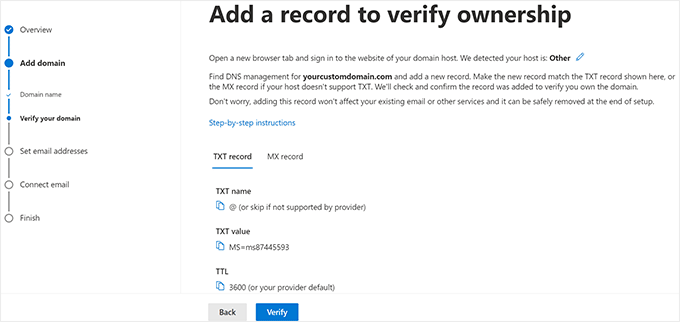
Switch back to Domain.com and log in to access your domain settings.
Select your domain name and then click on the ‘DNS and Nameservers’ menu.
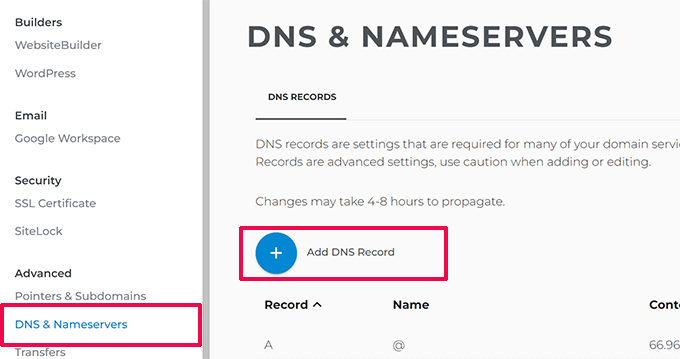
First, you need to select the TXT record and enter the value shown by Microsoft 365.
Next, save the settings by clicking the ‘Add DNS’ button.
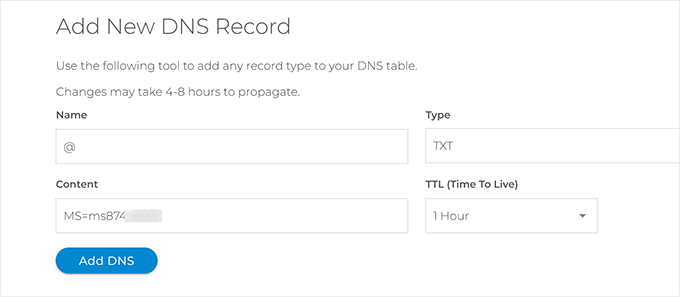
After that, repeat the process, and this time, select MX under the DNS record Type.
Copy and paste the MX record value from Microsoft 365.
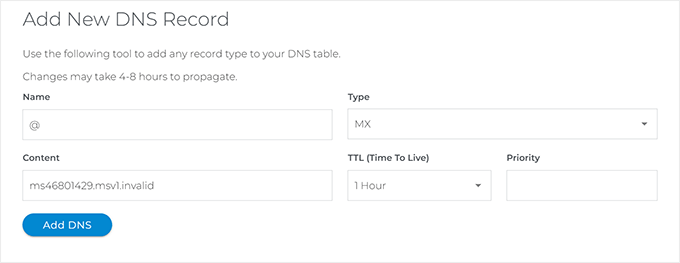
Don’t forget to click the ‘Add DNS’ button to store your changes.
After that, switch back to the Office365 setup screen and click on the ‘Verify’ button.
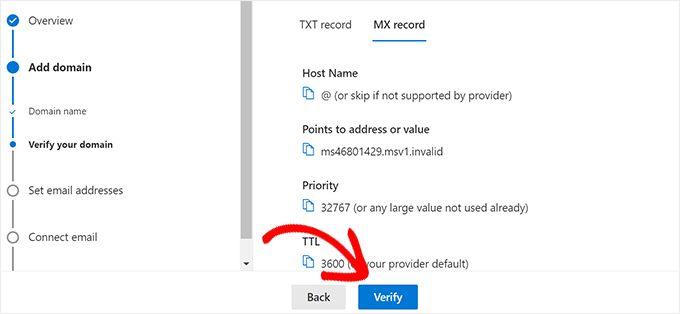
After the verification, you will be prompted to create an email address.
This will be your first email address with your custom domain name.
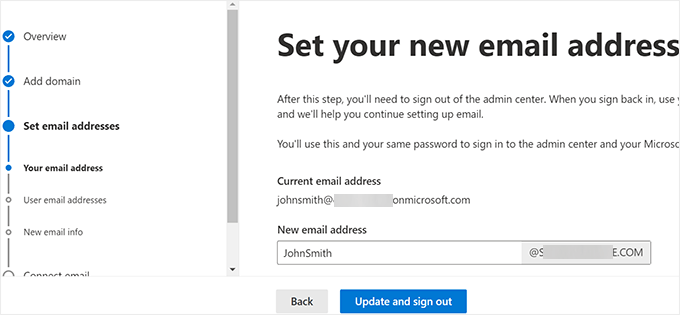
Your new custom domain email account will now become your admin email account for Office365.
You can now click on the ‘Update and sign out’ button to continue.
After that, log in to the Microsoft 365 admin console with your custom domain email address.
The setup will continue where you left off. You will now be asked to add additional DNS records to your domain name.
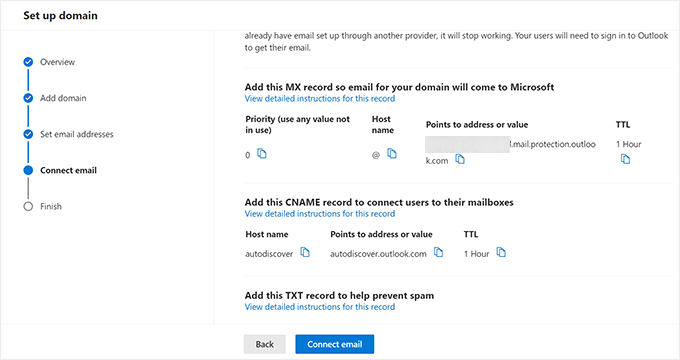
After adding those DNS records, click the ‘Connect email’ button to continue setup.
Office365 will now check your DNS records and finish the setup.
Step 3. Using your Microsoft 365 custom domain email account
Microsoft offers a web version of their popular Outlook email software called Outlook.com. From here, you can simply log in using the email address you created earlier.
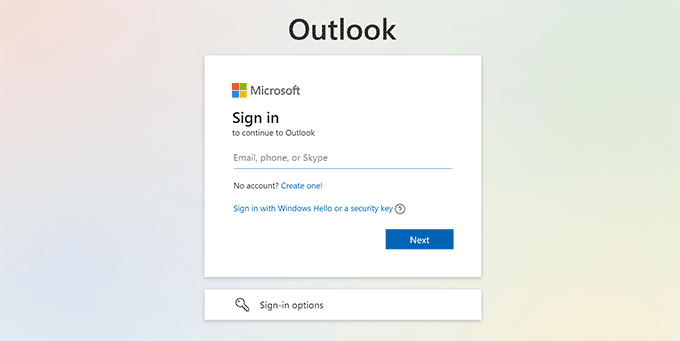
Depending on your Microsoft 365 subscription plan, you can also download Microsoft Office apps like Word, Excel, PowerPoint, and more on your computer.
This also includes their popular Outlook email client.
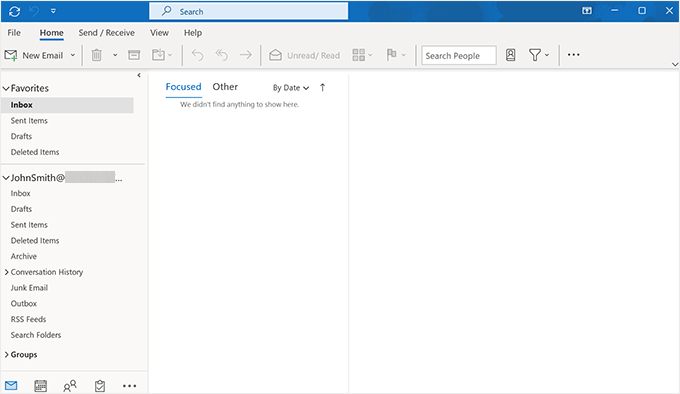
You can also use your custom domain email address with the Outlook app on your mobile phone.
If you prefer to use another app, your email address will work with just about any mail client and app without any special configuration.
Which Is Truly the Best Free Email Domain Option?
We have shown you three free email domain solutions and two paid ones. All of them would work well for small businesses and even large enterprises.
Most small business owners start with a free custom email domain offered by their web hosting service provider. This option is extremely affordable because it’s included in a package deal when you build a website.
Companies like Bluehost, Hostinger, and HostGator give you free business email addresses with your free domain when you use their hosting service to build a WordPress website.
As your business grows and you can afford the extra $6 per month, you can use Google Workspace. It gives you the familiar Google apps Gmail, Drive, Calendar, and more with your business name. It is easy, secure, and comes with the best spam protection in the industry.
We use Google Workspace in our own business.
But remember, you don’t want to register your domain with Google Workspace because you likely want to build a website using that domain name, and Google does not offer a website builder.
Instead, you should register your domain name with a proper domain registrar like Domain.com or use a WordPress hosting company like Bluehost to get a domain and build a website.
After that, you can use this custom domain in your Google Workspace settings so you can retain complete control over your domain at all times.
We hope this article helped you learn how to get a free email domain for your business. You may also want to see our guide on how to get a free SSL certificate for your website and our list of the best Google domain alternatives.
If you liked this article, then please subscribe to our YouTube Channel for WordPress video tutorials. You can also find us on Twitter and Facebook.





Dennis Muthomi
I found the comparison between free options and paid solutions like Google Workspace and Microsoft 365 especially helpful.
As someone who has moved from a free hosting provided email to Google Workspace I can attest to the benefits of better security, spam filtering and integration with other productivity tools.
I’d like to add a tip for the free options: While setting up your custom email domain make sure to also set up your SPF and DKIM records.
These additional DNS records will help with email deliverability and reduce the chances of your emails being marked as spam.
Jiří Vaněk
I would currently add to your comment that SPF is now a requirement for domains. If a domain doesn’t have at least an SPF record set, you likely won’t be able to send an email to a @gmail.com address because Google considers emails from domains without SPF as unwanted. The advantage is that Google sends error messages back with the reason, so the sender at least knows their message wasn’t delivered and why. So, SPF is no longer just a recommendation but an absolute necessity. Additionally, many people have delivery issues due to SPF when they use the standard PHP mail() function instead of SMTP.
Anthony O'Keeffe
Is that Bluehost offer free for ONLY the first year, please?
WPBeginner Support
Hosting signup discounts are only for the first signup period at the moment.
Admin
Moinuddin Waheed
I have used bluehost and have used the free email domain service by it.
having a domain email looks like a professional and gives a sense of branding for the buisness or blog.
I was hesitant earlier to use it but as it is very simple steps to follow and also we can get these emails gets delivered in our free Gmail account or in other email apps like outlook, it is good to have domain email.
Thanks for the step by step guide.
WPBeginner Support
Glad our guide was helpful
Admin
Ralph
Thanks for this guide. In the beginning every blogger want to save every penny but after years of blogging and making it my fulltime income leaving my job – just spend that 10 dollars to look more professional. Don’t be afraid and give your best. This will bring some money making possibilities. You just have to treat it like investment, not a cost.
Leland Garner
Thanks for this excellent guide. I use Google Workspace but for a friend I set up email at Zoho. Do you think Zoho is still a good option as well?
WPBeginner Support
We have not recently reviewed Zoho for any changes in its quality but when we will look into them for future updates
Admin
bina
Hi! Thanks so much for this guide, it was so helpful. I successfully linked my account from bluehost to google and am able to send e-mails from my domain, but I’m unable to receive emails from the account. Did I miss a step? Would you be able to help me fix this? Thanks so much
WPBeginner Support
You would want to reach out to BlueHost and they should be able to assist but more than likely you missed a step with the SMTP setup.
Admin
Omer Yousuf
Thanks for sharing the info, it does give me some peace of mind before proceeding with creating a custom domain email.
WPBeginner Support
Glad our guide could be helpful
Admin
Michael Oladipo
If I use a host, I don’t need to worry about creating a website for now? Please help, I will create a website in future but I need the email now, how can I use host for the G-Suite? Thanks.
WPBeginner Support
If your host is not one listed on this guide, you would want to reach out to them and they can assist with creating your email.
Admin
Smith
Thank you for the guidance..
WPBeginner Support
You’re welcome
Admin